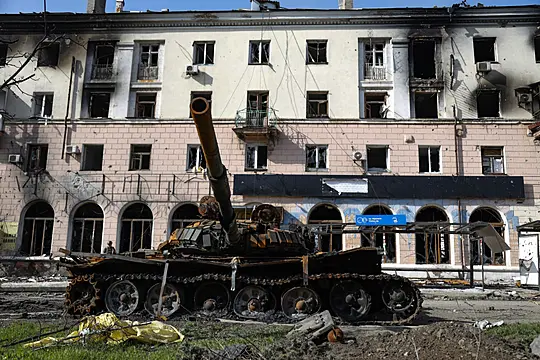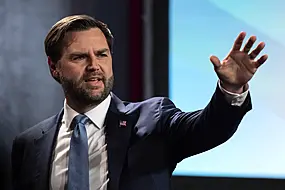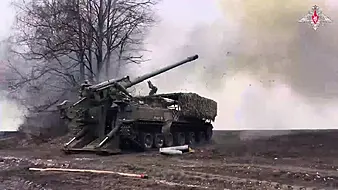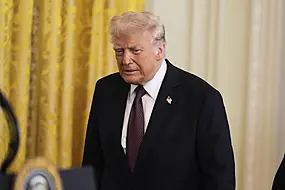US defence chief Lloyd Austin has urged Ukraine’s allies to “move at the speed of war” to get more weapons to Kyiv as Russian forces continued to bombard the country’s eastern and southern areas.
There are fears that the fighting could spill over Ukraine’s borders.
For the second day, explosions rocked the separatist region of Trans-Dniester in neighbouring Moldova, knocking out two powerful radio antennas.
Ukrainian authorities said a Russian missile also hit a strategic rail bridge linking Ukraine’s Odesa port region to Romania – a Nato member.
Just across the border in Russia, an ammunition depot in the Belgorod region is burning after several explosions were heard, the governor, Vyacheslav Gladkov, said on the messaging app Telegram.
Early this month, Russia said two Ukrainian helicopter gunships hit an oil reservoir in the same region, causing a fire.
Nato members Poland and Bulgaria have said the Kremlin is cutting off natural gas supplies starting on Wednesday, the first such actions of the war.
Poland has been a major gateway for the delivery of weapons to Ukraine and confirmed this week that it is sending tanks to the country.

The Polish government said it was well-prepared after working for years to reduce its reliance on Russian energy.
Warsaw also has ample natural gas in storage, and it will soon benefit from two pipelines coming online, analyst Emily McClain of Rystad Energy said.
Bulgaria gets more than 90% of its gas from Russia, and officials said they are working to find other sources, such as from Azerbaijan.
Both countries had refused Russia’s demands that they pay in roubles, as have almost all of Russia’s gas customers in Europe.

Two months into the fighting, Western arms have helped Ukraine stall Russia’s invasion, but the country’s leaders have said they need more support, and quickly.
US defence secretary Mr Austin convened a meeting on Tuesday of officials from about 40 countries at the US air base at Ramstein, Germany, and said more help is on the way.
“We’ve got to move at the speed of war,” Mr Austin said.
He said he wanted officials to leave the meeting “with a common and transparent understanding of Ukraine’s near-term security requirements because we’re going to keep moving heaven and earth so that we can meet them”.
I addressed the SFRC today, at a time when the need for an effective foreign policy has been set out in stark terms by the Russian government’s brutal war on Ukraine. The Kremlin’s aggression has highlighted all the ways we need U.S. diplomacy. pic.twitter.com/Q5gjunOexb
— Secretary Antony Blinken (@SecBlinken) April 26, 2022
After unexpectedly fierce resistance by Ukrainian forces thwarted Russia’s attempt to take Ukraine’s capital, Moscow says its focus is the capture of the Donbas, the mostly Russian-speaking industrial area in eastern Ukraine.
In the gutted southern port city of Mariupol, authorities said Russian forces hit the Azovstal steel plant with 35 air strikes over 24 hours.
The plant is the last known stronghold of Ukrainian fighters in the city. About 1,000 civilians were said to be taking shelter there with an estimated 2,000 Ukrainian defenders.
Petro Andryushchenko, an adviser to Mariupol’s mayor, said Russia was using heavy bunker bombs. He also accused Russian forces of shelling a route they had offered as an escape corridor from the steel mill.

Pavlo Kyrylenko, governor of the Donetsk region of the Donbas, said on the Telegram messaging app that Russian forces “continue to deliberately fire at civilians and to destroy critical infrastructure”.
Ukraine also said Russian forces shelled Kharkiv, the country’s second-largest city, which lies in the north-east, outside the Donbas. But it is seen as key to Russia’s apparent bid to encircle Ukrainian troops in the Donbas from the north, east and south.
Ukrainian forces struck back in the Kherson region in the south.
The attack Tuesday on the bridge near Odesa – along with a series of strikes on key railway stations a day earlier – appeared to signal a major shift in Russia’s approach.
Until now, Moscow has spared strategic bridges, perhaps in hopes of keeping them for its own use in seizing Ukraine. But now it seems to be trying to thwart Ukraine’s efforts to move troops and supplies.

No injuries were reported in the strike on the bridge, and Ukraine’s military said repair work is under way.
The southern Ukraine coastline and Moldova have been on edge since a senior Russian military officer said last week that the Kremlin’s goal is to secure not just eastern Ukraine but the entire south, so as to open the way to Trans-Dniester, a long, narrow strip of land with about 470,000 people along the Ukrainian border where about 1,500 Russian troops are based.
It is not clear who was behind the blasts in Trans-Dniester, but the attacks gave rise to fears that Russia is stirring up trouble to create a pretext to either invade Trans-Dniester or use the region as another launching point to attack Ukraine.
Ukrainian President Volodymyr Zelensky said the explosions were carried out by Russia and were “designed to destabilise”, with the intention of showing Moldova what could happen if it supports Ukraine.

Mr Austin said the US is still looking into blasts and trying to determine what was going on, but added: “Certainly we don’t want to see any spillover” of the conflict.
German defence minister Christine Lambrecht said her government will supply Gepard self-propelled armoured anti-aircraft guns to Ukraine. German Chancellor Olaf Scholz has faced mounting pressure to send heavy weapons such as tanks and other armoured vehicles.
Austin noted that more than 30 allies and partners have joined the US in sending military aid to Ukraine and that more than five billion dollars’ worth (£3.9 billion) of equipment has been committed.
The US defence secretary said the war has weakened Russia’s military, adding: “We would like to make sure, again, that they don’t have the same type of capability to bully their neighbours that we saw at the outset of this conflict.”
A senior Kremlin official, Nikolai Patrushev, warned that “the policies of the West and the Kyiv regime controlled by it would only be the break-up of Ukraine into several states”.
Russian foreign minister Sergei Lavrov cautioned that if the Western flow of weapons continues, the talks aimed at ending the fighting will not produce any results.







